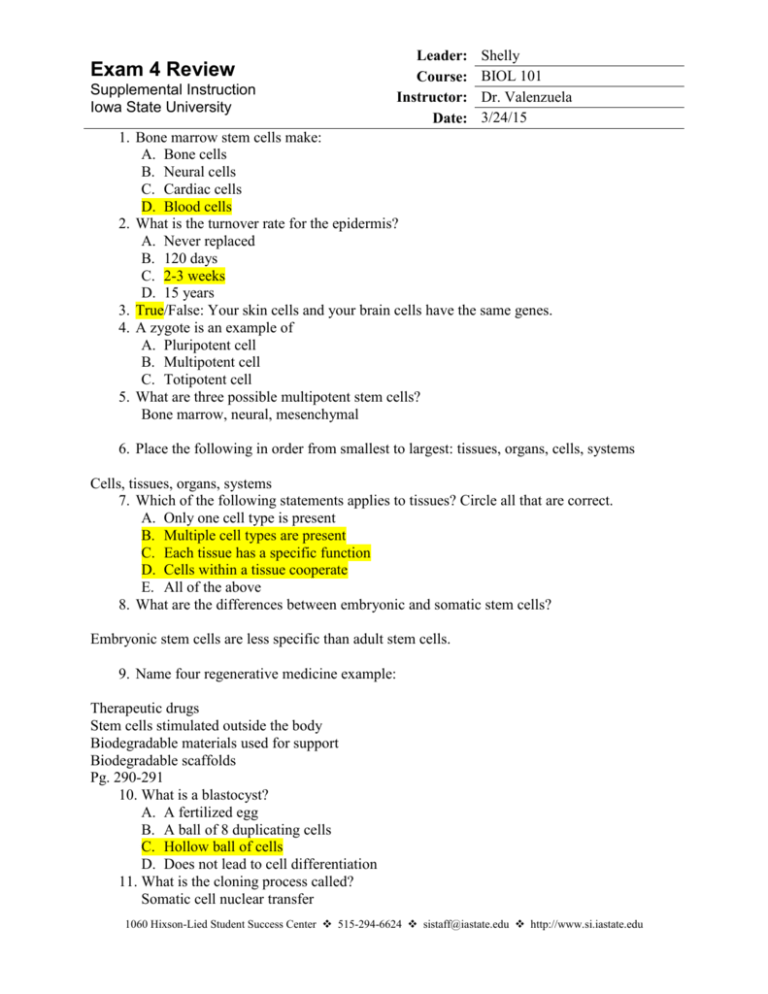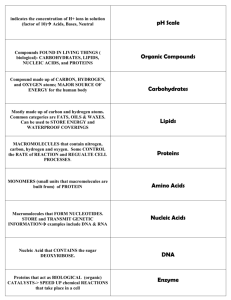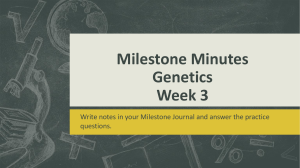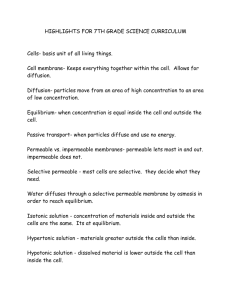Practice exam answers - Iowa State University
advertisement

Exam 4 Review Supplemental Instruction Iowa State University Leader: Course: Instructor: Date: Shelly BIOL 101 Dr. Valenzuela 3/24/15 1. Bone marrow stem cells make: A. Bone cells B. Neural cells C. Cardiac cells D. Blood cells 2. What is the turnover rate for the epidermis? A. Never replaced B. 120 days C. 2-3 weeks D. 15 years 3. True/False: Your skin cells and your brain cells have the same genes. 4. A zygote is an example of A. Pluripotent cell B. Multipotent cell C. Totipotent cell 5. What are three possible multipotent stem cells? Bone marrow, neural, mesenchymal 6. Place the following in order from smallest to largest: tissues, organs, cells, systems Cells, tissues, organs, systems 7. Which of the following statements applies to tissues? Circle all that are correct. A. Only one cell type is present B. Multiple cell types are present C. Each tissue has a specific function D. Cells within a tissue cooperate E. All of the above 8. What are the differences between embryonic and somatic stem cells? Embryonic stem cells are less specific than adult stem cells. 9. Name four regenerative medicine example: Therapeutic drugs Stem cells stimulated outside the body Biodegradable materials used for support Biodegradable scaffolds Pg. 290-291 10. What is a blastocyst? A. A fertilized egg B. A ball of 8 duplicating cells C. Hollow ball of cells D. Does not lead to cell differentiation 11. What is the cloning process called? Somatic cell nuclear transfer 1060 Hixson-Lied Student Success Center 515-294-6624 sistaff@iastate.edu http://www.si.iastate.edu 12. How do bacteria reproduce? A. Meiosis B. Mitosis C. Sexually D. Binary fission 13. What are two ways bacterial populations can acquire genetic variation? mutations and gene transfer 14. True/False: Individuals evolve and populations are selected. 15. It is advantageous for flowers to be medium length because short flowers don’t get enough sunlight, tall flowers have wind damage. What type of selection is this? A. Stabilizing B. Directional C. Diversifying 16. Name three ways you can prevent antibiotic resistant bacteria Wash your hands Don’t use antibiotics for virus Reduce antibiotics in livestock 17. What does MRSA refer to? A. S. aureus bacteria that are resistant to many antibiotics B. A collection of skin and other infections caused by a type of bacteria C. S. aureus bacteria that are found only in humans with certain types of skin infections D. S. aureus bacteria that are normal residents of human skin in the vast majority of the human population E. All bacteria that are resistant to antibiotics 18. Over time, natural selection leads to ____________. A. Genetic variation B. Adaptation C. Evolution D. Fitness 19. The evolution of antibiotic resistance is an example of A. Directional selection B. Diversifying selection C. Stabilizing selection D. Random selection E. Steady selection 20. What is the environmental pressure in the case of antibiotic resistance? A. The growth rate of bacteria B. How strong or weak the bacterial cell walls are C. The relative fitness of different bacteria D. The presence or absence of antibiotics in the environment E. The temperature of the environment 21. Natural selection is A. Nonadaptive, increases genetic diversity B. Nonadaptive, decreases genetic diversity C. Adaptive, increases genetic diversity D. Adaptive, decreases genetic diversity 22. What is genetic drift? A. Allele frequencies change due to chance events B. Alleles move from one population to another C. New alleles are created randomly D. Individuals with favorable alleles reproduce 23. Explain bottleneck effect and founder effect. Bottleneck- population suddenly reduced Founder- small group leaves a population to start a new one Pg 336 24. Genetic drift (reduces/increases) genetic diversity. Gene flow (increases/decreases) genetic diversity. 25. What is the Hardy-Weinberg equation? Pg 342 26. Explain seven ways species are reproductively isolated: pg 346 Ecological isolation Temporal isolation Behavioral isolation Mechanical isolation Gametic isolation Hybrid inviability Hybrid infertility 27. Genetic diversity is measured in terms of allele frequencies. A population of 3,200 mice has 4,200 dominant G alleles and 2,200 recessive g alleles. What is the frequency of g alleles in the population? 2,200/6,400 28. Which population has the highest genetic diversity? Each has 1,000 members. 1) 70% have A1/A1, 25% have A1/A2, 5% have A1/a 2) 50% have A1/A1, 20% have A2/A2, 10% have A1/A2, 10% have A2/a, and 10% have a/a 3) 80% have A1/A1, 20% have A1/a 29. A bottleneck is best described as A. An expansion of a population from a small group of founders B. A small number of individuals leaving a population C. A reduction in the size of an original population followed by an expansion in size as the surviving members reproduce D. The mixing and mingling of alleles by mating between members of different populations E. An example is natural selection 30. A population of ants on a median strip has 12 different alleles, A through L, of a particular gene. A drunk driver plows across the median strip, destroying most of the median strip and 90% of the ants. The surviving ants are all homozygous for allele H. What is the impact of this event on the frequency of alleles A through L? What type of event is this? Genetic drift All alleles except the H ones will equal 0. H alleles would equal 100% 31. Which is true of non-evolving populations? A. Allele frequencies don’t change over generations B. Genotype frequencies don’t change over time C. Individuals choose mates with whom they share many alleles D. All of the above E. A and B 32. Why is inbreeding detrimental to a population? Passes on the recessive alleles and reduces the heterozygous alleles. 33. The biological species concept defines a species A. On the basis of similar physical appearance B. On the basis of close genetic relationships C. On the basis of similar levels of genetic diversity D. On the basis of the ability to mate and produce fertile offspring E. On the basis of recognizing one another’s mating behaviors 34. http://www.indiana.edu/~l111/handouts/hardy.htm Hardy- Weinberg practice 35. A bird with a mating dance only attracts species of its kind, what type of reproductive isolation is this? A. Mechanical B. Gametic C. Temporal D. Behavioral 36. A mule is a cross between a horse and a donkey, and it cannot produce offspring. What type of reproductive isolation is this? A. Temporal B. Ecological C. Hybrid in viability D. Hybrid infertility 37. Which of the following is most likely to leave a fossil? A. Jellyfish B. Worm C. Wolf D. Sea sponge E. All of the above 38. You are examining a column of soil that contains vertebrate fossils from deeper to shallower layers. Would you expect a fossil with four limbs with digits to occur higher or lower in the soil column relative to a standard fish? Why? Fossil with limbs would be the fossil of recent organism standards. Fish would be deeper. 39. Which of the following features of Tiktaalik is not shared with other bony fishes? A. Scales B. Teeth C. Mobile neck D. Fins E. None of the above 40. What are the similarities between an eagle wing with the structure and function of a human arm: Same bones and structure. Human arms have more fine motor movement. 41. What are four characteristics to a tiktaalik? Ribs are long and sturdy to support the body on land Pectoral fins can support their body weight Mobile neck Head is long and flat






